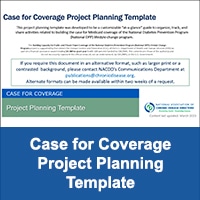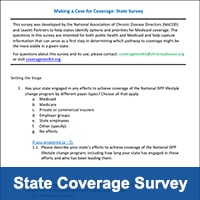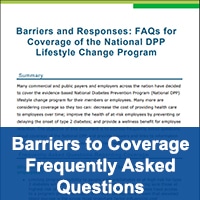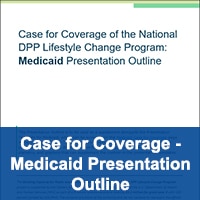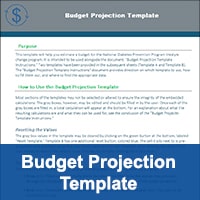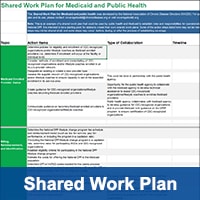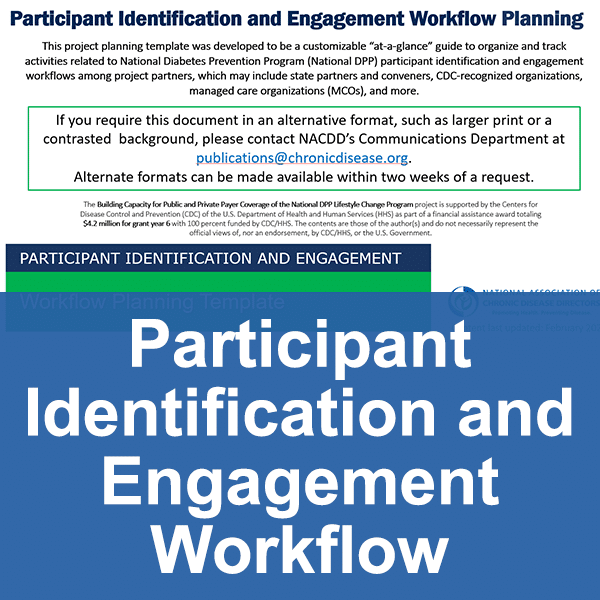Medicaid → Medicaid Coverage → Case for Coverage
Case for Coverage for Medicaid
Making the Case for Coverage for State Medicaid Agencies
This page is written for public health professionals to provide guidance for working with their Medicaid colleagues to make the case to cover the National DPP lifestyle change program. While public health is the primary audience for this section, the content is also relevant for Medicaid professionals.
The page is broken down into five stages for making the case to cover the National DPP lifestyle change program in Medicaid. Click on a link below to go directly to that stage.
- Stage 1: Building Relationships between Public Health and Medicaid
- Stage 2: Assessing Medicaid Coverage Options
- Stage 3: Preparing and Presenting the Case for Coverage
- Stage 4: Assessing Success through Evaluation and Measurement
- Stage 5: Post Program Launch
- Resources
Why Making the Case for Coverage is Important
The National DPP lifestyle change program’s ability to improve health in participants and reduce health costs is supported by a significant amount of evidence. Unfortunately, this evidence is not widely known. To secure Medicaid leadership support for the National DPP lifestyle change program, they need to understand this evidence, as well as key decision points needed to plan a successful delivery.
States interested in making the case for Medicaid coverage can utilize the Case for Coverage Project Planning Template which was developed to assist with the planning phases of this work (stages 1 – 3). The template is meant to serve as a guide for organizing thoughts and tracking efforts related to making the case for Medicaid coverage and can be adapted to fit the needs of individual states or organizations.
Stage 1: Building Relationships between Public Health and Medicaid
An emphasis on building relationships between public health and Medicaid has been at the center of recent initiatives focused on Medicaid coverage for the National DPP lifestyle change program, including the Medicaid Coverage for the National DPP Demonstration Project and the states working on CDC’s 6|18 Initiative.
Several factors are important to keep in mind when establishing these relationships, including whom to reach out to, how to approach and engage colleagues, and how to establish and maintain collaboration. General considerations when building a relationship between public health and Medicaid include:
- Find the right person to connect with in Medicaid. This could be a colleague who has an interest in prevention and a place at the table for Medicaid coverage conversations in your state. Possible places to start are the “Benefits,” “Planning,” “Managed Care,” “Population Health,” “Quality Improvement,” or “Innovation” sections of Medicaid. Descriptions of these sections, or functional units, are provided in the table below. If you have connections with the Medicaid Director or other Medicaid staff, they may be able to direct you to the right person.
- Engage leadership early in the support of a public health and Medicaid partnership. Inform your agency leadership of your efforts and encourage him or her to reach out to his or her counterpart. Continue to provide regular updates to your leadership about any public health/Medicaid collaboration.
- Take time to understand the other agency’s mission, values, and goals. For public health professionals, some helpful Medicaid 101 webinars are located here.
- Extend invitations and attend each other’s stakeholder meetings (e.g., Diabetes Prevention Advisory Group meetings, Medicaid managed care organization (MCO) meetings, and quality improvement meetings) with the purpose of communicating and finding points of common interest.
- Organize regular meetings outside of those larger stakeholder meetings to maintain communication and continue the relationship. The focus of these meetings could include discussion and exchange of agency goals and agendas; ways that Medicaid and public health could work together and pursue common interests; and program development related to chronic disease prevention.
Functional Units within Medicaid
Different functional units within Medicaid will have a role in implementing the National DPP lifestyle change program as a Medicaid-covered benefit. Connecting with and establishing good working relationships with Medicaid officials in one or more of these areas could help generate movement toward Medicaid coverage of the National DPP lifestyle change program in your state.
It is important to note, however, that Medicaid agencies are structured differently in different states. Therefore, it may require some research to determine where these functional units are housed within your state’s Medicaid agency (and what the corresponding division, office, unit, or position may be named), the best unit to contact, and at what stage in the case for coverage process it would be appropriate to contact them.
There is also some overlap between the different functional units. As such, a state’s administrative structure may not exactly follow the delineation of duties outlined below. Some states may have organizational units that house a combination—or just a portion—of the various functional units based on agency structures, staffing, budgets, and program initiatives.
General Descriptions of Units within Medicaid
Benefits: Ensures that the Medicaid agency complies with state and federal benefit requirements. Researches benefit related options and structures (such as how the National DPP lifestyle change program benefit would be structured and delivered and what provider types could be reimbursed for delivering the program). Involved in initiating and implementing Medicaid benefit changes to meet both federal and state program needs.
Planning: Engaged in Medicaid program related research and may be closely involved with the strategic planning, direction, coordination, and implementation of the Medicaid agency’s programs, policies, and procedures.
Managed Care: Oversees most components of the Medicaid agency’s managed care programs, including contracting and evaluation. Involved with determining the inclusion or exclusion of Medicaid covered benefits in managed care. Oversees how “in lieu of” and value-added services are structured, delivered, and reimbursed through managed care plans.
Quality Improvement: Oversees quality improvement using evidence-based tools to achieve the Medicaid agency’s quality goals, which may be based on the triple aim of better health, better care, and lower costs. The state will likely have a defined set of measures, such as the Healthcare Effectiveness Data and Information Set (HEDIS), Consumer Assessment of Healthcare Providers and Systems (CAHPS), or other state-developed measures, which are used to oversee and coordinate with managed care plans (MCOs or accountable care entities) on health outcomes.
Population Health Management: Uses program data to develop and implement strategies and interventions designed to achieve Medicaid’s quality improvement performance goals. May oversee the development of Medicaid policies and procedures to increase the effectiveness of population health programs. These policies and procedures may focus on identifying the opportunities to address and improve health disparities and population-based health outcomes for targeted beneficiaries.
Innovation: May play a lead role in the strategic planning, direction, coordination, and implementation of the Medicaid agency’s policies and programs. May have some responsibility for managed care programs, delivery system and payment reform initiatives, health equity and health disparity initiatives, and program evaluation. May also play a key role in 1115 demonstration designs.
Chief Medical Officer or Medical Director: Provides clinical leadership and guidance to the Medicaid agency, provides guidance on medical-related services, and assists or oversees the determination of medical care provided to recipients. May also provide medical consultation in the development and modification of health care policies and procedures and the implementation of health care delivery systems.
Demonstrate the Value of Collaborating with Public Health
Although it is ultimately Medicaid that will implement the policy changes, public health can bring valuable expertise and resources to the collaboration. Given that Medicaid agencies often face limited staff and budgets for innovation, public health can contribute staff time and effort that may otherwise not be available within Medicaid.
Public health can support Medicaid staff:
- Public health can provide information and analysis on factors such as: costs associated with diabetes care, estimated return on investment (ROI) of coverage, and the evidence supporting the National DPP lifestyle change program. More information on calculating the ROI can be found on the Cost and Value page of the Coverage Toolkit.
Public health can increase access to services for Medicaid beneficiaries through:
- Outreach and education to partners, health care providers, and beneficiaries. Information on how to outreach to these groups can be found on the Recruitment and Referral page of the Coverage Toolkit.
- Expansion of community-based care available to Medicaid beneficiaries.
Public health can be an innovation partner with Medicaid resulting in:
- Increased focus on alternative payment models and population health.
- Increased use of managed care, care coordination, and social supports.
Potential Communication Challenges
A general survey was conducted with Medicaid and public health in Colorado in 2014 to better understand where the gaps in communication between the two agencies occurred. The four main themes from the survey will likely resonate with public health and Medicaid staff in states beyond Colorado:
Theme 1
Staff were unsure with whom to collaborate at each agency.
Public health staff:
“Strong desire to collaborate but often unknown which Medicaid staff member is the ‘right’ person to talk to and how to best communicate with their staff.”
Medicaid staff:
“Other than attending a few meetings with some public health staff I have had no contact…I am sure there would be areas where collaboration would be useful I just don’t know enough about the state public health agency to say what they would be.”
Theme 2
Perception that collaboration only occurs once programs are underway, rather than proactively.
Public health staff:
“[Collaboration is needed in the] preplanning phase. Often, we are working on projects after the fact.”
Theme 3
There is a desire to collaborate, specifically in the areas of data sharing and cross promotion of services and materials.
Public health staff:
“I am sure there are lots of opportunities to better understand how their data can be used in evaluating our health systems initiatives.”
Medicaid staff:
“It seems we could work better together to get the word out to the public about services and benefits available to Medicaid clients. Medicaid never has the resources to do this kind of work, but public health often does, so that’s an obvious connection.”
Theme 4
Staff from both agencies were not confident in their understanding of each other’s mission/values/goals or organizational structure.
Public health staff:
“I am not even sure where my colleague sits within the Medicaid agency, who they report to, or what the goals of their section within the agency are!”
Stage 2: Assessing Medicaid Coverage Options
Medicaid coverage for the National DPP lifestyle change program has been achieved or is being piloted in a growing number of states. The role a state’s legislature can play in establishing Medicaid coverage for the program, and examples of National DPP related legislation, can be found on The Role of the State Legislature in Medicaid Coverage page of the Coverage Toolkit. The various pathways for states to receive federal Medicaid matching funds for Medicaid coverage of the National DPP lifestyle change program are described in the Medicaid Coverage section, including attaining coverage through a Medicaid State Plan, a Section 1115 Demonstration Waiver, or Medicaid Managed Care Options.
It is important to consider organizational, structural, and political factors when determining which pathway is the most viable for a state. NACDD and Leavitt Partners developed a survey to help states identify options and priorities for Medicaid coverage. The questions in this survey are intended for both public health agencies and Medicaid agencies, and help capture information that can serve as a first stage in determining which pathway to coverage might be the most viable in a given state. To access the survey, click the icon below.
Stage 3: Preparing and Presenting the Case for Coverage
Identify Decision Makers and Potential Advocates
A key step to preparing the case for coverage is identifying the decision-makers in a state who are likely to evaluate the case for Medicaid coverage of the National DPP lifestyle change program. In some states, this could mean meeting with the state Medicaid Director and/or Medicaid Medical Director, engaging the state advisory committee*, and/or educating the state legislature through stakeholders or “diabetes caucus” opportunities.
It is also important to find someone in a leadership position from either public health or Medicaid who can serve as a “champion” for the program and bridge the gap between Medicaid and public health leadership.
Two channels of communication between public health and Medicaid agencies should be established: 1) at the programmatic or operational level (i.e. the agency staff who would be responsible for operationalizing the benefit if a coverage decision is made), and 2) at the leadership level (i.e. the agency staff responsible for approving the coverage decision).
*Note: All Medicaid Directors are required by federal regulation to have a state advisory committee in place. Some representatives on the committee are there by statute and some are appointed. In general, most of a state’s major provider groups are included on the committee. Examples of advisory committee representatives include the state hospital association, a Medicaid beneficiary representative, public advocacy organizations, and individual health care providers (e.g., emergency room doctor).
Consider the Timing
The timing of any communication is important and may impact a decision-maker’s receptiveness to considering the case for coverage of the National DPP lifestyle change program. Times when a state Medicaid agency may be better positioned to engage about the program may include:
- In advance of a state’s waiver renegotiation timeframe.
- Prior to MCO contract renegotiations or request for proposals (RFP) deadlines. To learn more about MCO procurement timelines please visit the State MCO Contracts and Contract Amendments page of the Coverage Toolkit.
- Intersected with a state Medicaid agency’s coverage decision making process.
Decision-Making Process Examples
The decision-making process for Medicaid leadership to cover a service will vary from state to state and often is not well documented. The following table includes some examples:
Select State Agencies
An article published in August 2015 by Manatt and the California HealthCare Foundation titled In or Out: An Examination of Medicaid’s Coverage Determination Policies explored how large public health insurance programs in the U.S. and abroad make coverage decisions for specific interventions. As part of this review, it highlights select state Medicaid agencies and describes how they are covering behavior change interventions. The article also discusses policies and procedures for ensuring these decision-making processes are transparent and follow specific guidelines.
Center for Evidence-Based Policy
A broader resource for states making coverage decisions in Medicaid is the Center for Evidence-based Policy at the Oregon Health and Science University. This center works with federal, state, and local policy makers across the United States to use evidence to guide decisions and improve the health of constituents. The center runs a group called the Medicaid Evidence-Based Decisions Project (MED), which publishes reports to help state Medicaid agencies and their stakeholders make sound decisions about coverage. They published a report in 2017 on Diabetes Prevention that evaluated the long-term effects of the National DPP lifestyle change program and similar interventions on individuals with prediabetes and within different program delivery modes and population subgroups.
Address Questions About the National DPP Lifestyle Change Program
When discussing the program with decision-makers and potential advocates, it may be necessary to address questions about the National DPP lifestyle change program such as, “Why can’t this be a ‘one size fits all’ program for all beneficiaries,” and “A year is a long time; can we shorten the program?” The Barriers to Coverage FAQ document seeks to address frequently asked questions about coverage of the National DPP and provide answers and links to information on the National DPP Coverage Toolkit.
Case Studies
Case studies and other examples can also be a helpful way to convey the path to coverage of the National DPP lifestyle change program to decision-makers and generate interest in the program. For example, the State Stories of Medicaid Coverage page describes the approaches many states took to achieve coverage and can help other states think through how they could cover the National DPP lifestyle change program for Medicaid. Additionally, the Medicaid Coverage for the National DPP Demonstration Project page describes a multi-year project that was carried out in two states, Maryland and Oregon, to work through and develop solutions for the real-world challenges of Medicaid coverage for the National DPP lifestyle change program.
Gather Data and Create a Budget Projection
Once the relationship between public health and Medicaid has been established, it is important to consider which information and resources to share to make a case for coverage. The purpose of creating a case for coverage is to convince a decision-maker that it is advantageous for Medicaid to cover the National DPP lifestyle change program. A key piece of that argument is demonstrating that the program can improve beneficiary health and reduce health care costs.
Data Resources
The following resources contain data in support of covering the National DPP lifestyle change program:
Cost & Value
The Cost and Value page of this toolkit compiles several resources describing the cost of diabetes, evidence for the cost-effectiveness of prevention through the National DPP lifestyle change program, and the value on investment (VOI) for covering the program.
Evidence-based Reports
The Evidence page of the toolkit also contains numerous evidence-based reports demonstrating support for coverage of the National DPP lifestyle change program within Medicaid.
State Data
Understanding the impact of prediabetes and type 2 diabetes in a state or in a community can lead to a greater understanding of the importance of prevention efforts like the National DPP lifestyle change program.
Examples of How States Present Data
Presenting data on diabetes prevalence and costs can be even more impactful when organized in a simple, concise, and visual way. The links below are examples of how states have presented diabetes-related data.
- Utah Medicaid Coverage of the National DPP One-Pager
- Colorado DSMES Education Brief and Analysis
- Colorado National DPP One-Pager
- Virginia HB 1098 Potential Solution National DPP Brief
State Data Sources and Ideas
Using the data sources noted in the table below, states and their partners can curate specific data to help build the case for coverage of the National DPP lifestyle change program. More details on the data sources in the table and additional sources are provided in the section below. Please note these are hypothetical examples, and do not represent real data from specific states.
| Ideas for Using State Data to Make the Case for Coverage | Where to Gather These Data |
| Diabetes prevalence and costs: 11.3% of adults in XX state have type 2 diabetes. This equates to 565,000 adults statewide and results in an estimated $3.8 billion annual cost to XX state. Additionally, an estimated 1 in 3 adults have prediabetes, which equates to nearly 2 million adults in the state. Adults with prediabetes are at high risk of developing type 2 diabetes, which results in significant health and economic costs. | Data sources: State-specific BRFSS data and the CDC Diabetes Atlas provide diabetes prevalence estimates. The ADA provides estimates of costs. Data notes: Multiplying the total state population by the share of the population with diabetes and prediabetes can provide an estimate of the number of people living with these conditions. Providing both a percentage and a number can help a reader better understand the magnitude of the problem. Note that if diabetes prevalence data are for adults only, then only the adult population total should be used in calculations. Example calculation: 11.3% (adult diabetes prevalence) X 5,000,000 (adult population in state) = 565,000 adults with diabetes. |
Prevalence of type 2 diabetes and prediabetes in Medicaid:
Diabetes and prediabetes are more prevalent in the Medicaid population. For example:
|
Data sources: State Medicaid agencies can use Medicaid claims data to determine the number of Medicaid beneficiaries with diagnosed type 2 diabetes and the estimated number of beneficiaries who could be eligible for the National DPP lifestyle change program.
Data notes: States may use a variety of methods to estimate the number of individuals eligible for the program, including:
|
The cost of type 2 diabetes and prediabetes to Medicaid and possible cost savings of the National DPP lifestyle change program:
Diabetes can lead to serious health problems and result in significant health care costs. For example:
|
Data sources: State Medicaid agencies can calculate the average annual cost per enrollee for Medicaid beneficiaries with and without diabetes. Taking the difference between these two averages provides an estimate of how much excess money is spent on diabetes-related expenses. Example calculation: $13,000 (average annual cost per enrollee with diabetes) - $5,000 (average annual cost per enrollee without diabetes) = $8,000 (estimate of excess money spent on diabetes-related expenses). Data notes: Contextualizing the values obtained through the calculation above, with the number of Medicaid beneficiaries with prediabetes (see row above), and the estimated cost of the program, can further illuminate the benefits of the National DPP lifestyle change program and the potential for savings. Example contextualization: $8,000 (estimate of excess money spent on diabetes-related expenses per enrollee per year, see example calculation above) vs. $700-$1,500 (estimate of the cost of the National Diabetes Prevention lifestyle change program per enrollee per year). Many studies have been conducted on diabetes-related costs in Medicaid; several of these studies are summarized here. |
| The cost of type 2 diabetes medication compared to the cost of the National DPP lifestyle change program: The cost of medication used to treat type 2 diabetes is high, particularly medication classes GLP-1, SGLT2, DPP-4 and the newer combination GIP/GLP-1. The American Diabetes Association (ADA) recommends using these medication classes when co-morbid conditions (including high blood pressure, end-stage renal disease, and cardiovascular disease) exist rather than lower cost alternatives like metformin. These medication classes can be among the top 25 most expensive medications for a Medicaid managed care plan. Retail prices for these medications may range from $400 to $1500 per month, which is similar to the cost of providing the National DPP lifestyle change program for one year. | Data sources: Estimates for the amount of money spent on diabetes-related medication can be found using data from Good Rx, but these are retail prices, which are likely discounted for Medicaid. A state Medicaid office or a Medicaid managed care organization (MCO) can provide more exact cost estimates for diabetes-related medication. |
| Highlighting how the National DPP lifestyle change program can address health equity: Some areas in XX state face higher social vulnerability based on the CDC’s social vulnerability index. These areas also tend to be lower-income and have higher rates of diabetes. Offering the National DPP lifestyle change program through Medicaid can help reduce these disparities and improve health equity. | Data sources: The CDC Diabetes Atlas and Social Vulnerability Index maps social vulnerability, or the potential negative effects on communities caused by external stresses on human health. This tool provides data down to the county-level, which is a more regional view of risk. |
Budget and Impact Tools
The tools listed below are available to help assess potential costs and savings related to the National DPP lifestyle change program, including evaluating the economic burden of diabetes in the state. Additional information describing the value of the National DPP lifestyle change program can be found on the Cost and Value page.
Budget Projection Template
The Budget Projection Template (click the icon to download) can be used to estimate the total cost of providing the National DPP lifestyle change program to eligible beneficiaries, as well as the average cost per participant. The Medicaid Budget Projection Template Instructions (click the icon to open) is meant to be used alongside the Budget Projection Template to help the user identify the decisions and data needed. It also explains how to interpret the results of the Budget Projection Template.
Impact Toolkit
The CDC Diabetes Prevention Impact Toolkit is a user-friendly, interactive website that allows commercial plans and employers to assess the likely cost-effectiveness or cost-savings of covering the National DPP lifestyle change program. The default values in the Impact Toolkit are based on the best available data from relevant research, program implementations, state and industry averages, and expert judgment. Users of the Impact Toolkit can adjust those values based on the population served, expected adherence levels, program cost, and more.
State Burden Toolkit
For state Medicaid and public health, the CDC’s Diabetes State Burden Toolkit provides information on the health, economic, and mortality burden of diabetes, which can be used in cost-analyses. The default values in the Diabetes State Burden Toolkit are based on the best available data from relevant research. Users of the Toolkit can view the different burden information by selecting from the subcategories in each module.
A state Medicaid agency is likely to be most responsive to data that is reflective of the Medicaid beneficiaries in the state. For example, data that matches the age, gender, socioeconomic status, or geographic location of the population of interest is more persuasive.
Unique Considerations for Medicaid
Medicaid coverage of the National DPP lifestyle change program has many unique considerations that could affect the impact the program would have if implemented. For example, increasing coverage and access to a program proven to prevent type 2 diabetes is a way to promote health equity for Medicaid beneficiaries who are more likely to develop type 2 diabetes than non-Medicaid populations.
States that expanded Medicaid under the Affordable Care Act (ACA) have also seen their diabetes rates increase in their Medicaid populations, underscoring the need to target prevention. The demographics of the covered populations under “traditional” Medicaid programs (i.e., those states that have not expanded Medicaid eligibility) primarily include pregnant women, children under the age of five years, physically and mentally disabled persons who qualify for social security, persons who have substance abuse (addiction) issues, and adults in long-term care. In states that have expanded Medicaid eligibility, the federal government will cover 90% of the cost of direct services provided to newly eligible childless adults up to 138% of the federal poverty level (FPL). These states may be more likely to consider coverage of the National DPP lifestyle change program, as it may be more relevant and financially impactful for their covered population.
A former Medicaid director suggested taking into account the higher cost services that Medicaid already provides and linking those to potential cost savings of preventing diabetes.
Some key questions to consider include:
- What is the cost of NOT covering the program? How many Medicaid beneficiaries may go on to develop type 2 diabetes and experience higher costs associated with prescriptions, hospitalizations, ER visits, etc.?
- How many people in nursing homes paid for by a state Medicaid agency have type 2 diabetes? Does having type 2 diabetes raise those individual’s medical costs overall? What could the savings be if those beneficiaries had not developed type 2 diabetes?
- Women with gestational diabetes (GDM) who go on to have high-risk pregnancies and births result in significant costs for Medicaid. What are the potential cost savings if those individuals were to participate in the National DPP lifestyle change program following their pregnancies, thus lowering their risk for type 2 diabetes and potentially avoiding high-risk pregnancies for subsequent births?
Present the Case for Coverage
Methods of communication may vary according to state needs and individual preferences; however, several resources are available to help public health and Medicaid professionals communicate with one another and with decision-makers:
Case for Coverage Templates
- NACDD has created an editable Presentation Template for Medicaid, which can be used as a starting place when building a case for coverage presentation.
- To supplement the Medicaid Presentation Template, NACDD created the Case for Coverage: Medicaid Presentation Outline, which contains tips for presenting, and additional information, statistics, and graphics that can be added to the Medicaid Presentation Template.
- Additionally, see the Elevator Pitch for Medicaid Coverage of the National DPP Lifestyle Change Program document for talking points on how coverage of the program can benefit Medicaid and the communities being served.
- The American Medical Association created an editable case for coverage presentation template for health care organizations offering the National DPP lifestyle change program to their employees, which can be found here.
Budget Projection
Colorado Example
Colorado also developed an education brief and analysis that included a budget projection for the Diabetes Self-Management Education (DSME) program in 2015 when the state achieved Medicaid coverage for the program. While this was for the DSME program, there are many aspects to this brief that could be applied to making a case for coverage for the National DPP lifestyle change program.
Stage 4: Assessing Success through Evaluation and Measurement
Why Evaluate?
Planning to evaluate the impact of the National DPP lifestyle change program is an important part of the coverage discussion. There are several reasons why Medicaid would benefit from evaluating the program:
- Obtaining feedback to improve the delivery of the National DPP lifestyle change program
- Gathering data that demonstrates the value and effectiveness of the program
- Measuring changes over time against a baseline
- Securing continued stakeholder support for the program
- Establishing accountability for the use of resources
- Comparing the efficacy of the National DPP lifestyle change program to different interventions
Developing a comprehensive evaluation plan will support efforts to improve the National DPP lifestyle change program and can be done in any context, such as during a pilot, when the program is a fully covered Medicaid benefit, or within a commercial context. The data collected during an evaluation can be used for many purposes, including to guide benefit design, measure changes over time against a baseline, and establish accountability for the use of resources.
Montana is a state that has conducted rigorous evaluation on various aspects of the National DPP lifestyle change program since implementing Medicaid coverage. Montana has studied program adaptations for the Medicaid population, the effectiveness of the program for individuals with disabilities, the effects of financial incentives for program participants, differences in program effectiveness based on age, and the effectiveness of telehealth delivery of the program to rural populations. To learn more, visit the Montana State Story page of the Coverage Toolkit.
To learn more about evaluation methods and examples of other states that have evaluated the National DPP lifestyle change program, please see the evaluation section of the Data, Reporting, and Evaluation page.
What to Measure
When developing an evaluation plan, it is important to identify the questions of interest, how needed information will be collected, and how the results will be shared and utilized. Answering these questions will help the evaluation team define roles and responsibilities as they relate to the evaluation and ultimately set the evaluation up for success. Potential evaluation questions include:
- How many (and what proportion) of the state’s Medicaid population diagnosed with or at risk for prediabetes were engaged, enrolled, retained, and completed the National DPP lifestyle change program?
- How did delivery programs retain Medicaid participants? What were the factors associated with retention?
- Did Medicaid participants achieve the expected outcomes to meet the standards of the Diabetes Prevention Recognition Program (DPRP)? Which participants were most likely to achieve these outcomes? What benefits did participants experience through participation in the program? What were the social/behavioral outcomes?
CDC has some required measurements for the program including attendance and weight loss. Medicaid may consider tracking additional items to look at a larger impact and additional value components of coverage of the National DPP lifestyle change program, such as:
- Biometrics— A1Cs, lowering/decreasing medications, other biometric measurements (blood pressure, lipids, etc.)
- Claims— How have medical claims been affected (lower hospital admittance/ incidences)?
- Satisfaction— Were Medicaid beneficiaries positive about the programming and did they believe they benefited?
As part of an evaluation of the Medicaid Coverage for the National DPP Demonstration Project, NACDD worked with RTI international to assess, among other factors, participant satisfaction with the Demonstration program. The follow-up survey found that 93% of participants were satisfied or very satisfied with the program, 86% were satisfied or very satisfied with the lifestyle coaches, and 90% reported they were likely or extremely likely to recommend the program. They also found that 74% reported their overall health was better and 85% reported changing their physical activities or exercise routine. Additional results are outlined in the Evaluation page for the Medicaid Coverage for the National DPP Demonstration Project.
Visit the Data, Reporting, and Evaluation page of the Coverage Toolkit to learn more about the types of data Medicaid agencies can collect, data security and regulatory compliance, and additional considerations for evaluation of the National DPP lifestyle change program.
Stage 5: Post-Program Launch
Once the decision is made to cover the National DPP lifestyle change program, it will be critical for Medicaid and public health to continue to work together to support the operationalization and systems-building needed to support the new benefit. State agencies will also be tasked with educating beneficiaries, providers, and CDC-recognized organizations, as well as analyzing the use and outcomes of the benefit once it has rolled out. Some recommendations for success in this partnership include:
- Determine roles and responsibilities: these should be defined based on expertise and availability of time and resources. For example, a likely scenario could be Medicaid determining coding and billing procedures, and public health taking the lead on developing communication and outreach tools to educate providers and beneficiaries about the benefit. Public health could also support the referral processes between CDC-recognized organizations and health systems.
- Create a shared work plan: establish specific tasks, reporting mechanisms, and timelines for each agency’s responsibilities. An example of a shared work plan can be found here. Keep in mind that this tool is intended to be a starting point for states to create their own shared work plans; some of the information and action steps may occur at various points before, during, and after the process of establishing coverage.
- Address capacity: every state will need to determine how to enroll either lifestyle coaches or CDC-recognized organizations as Medicaid providers and ensure network adequacy in their state.
- Perform outreach activities: ensure health care providers, CDC-recognized organizations, and Medicaid beneficiaries are aware of the benefit and know the pathways to referral, reimbursement, and enrollment. Information on how to outreach to these groups can be found on the Recruitment and Referral page of the Coverage Toolkit. The Participant Identification and Engagement Workflow is a tool that provides prompts to assist state partners in brainstorming and developing individual workflows related to participant identification, outreach, referral, and engagement, as well as screening for health-related social needs (HRSN). Please visit the Medicaid and HRSN page to learn more about the role of Medicaid in addressing HRSN.
- Address other operational components: consider how the roll-out will affect partner organizations. CDC-recognized organizations in particular may need guidance or support for operational components such as enrolling as Medicaid providers and accessing the claims-based billing and coding system. Guidance on these systems and processes should be developed and disseminated, and training should be provided as needed. Examples of how other states have communicated this information to CDC-recognized organizations can be found here.
This is the same kind of cooperation and teamwork that was achieved between CMS and CDC after the decision was made to expand the model test in Medicare and cover the Medicare Diabetes Prevention Program (MDPP). The final MDPP rule published in November 2017 was over 300 pages long (which included responses to public comments) – highlighting the complexity in developing the rules and regulations that govern public health plan coverage decisions.
Resources to Help Make the Case for Coverage
Coverage Toolkit Resources
Other Resources
- ASTHO Medicaid and Public Health Partnerships: This site has multiple resources to support public health partnerships with Medicaid to improve population health.
- Case Study: Medicaid and Public Health Collaboration in Oregon: As stated at the beginning of the case study, “Oregon is one of the leading states engaged in innovative health care delivery system reform that includes population health as a central component. Collaboration among key agencies and stakeholders is an important feature of Oregon’s reform efforts.”
- CDC’s Diabetes Prevention Impact Toolkit: Use this interactive Impact Toolkit to project the health and economic effects of the National DPP lifestyle change program on your population at risk for diabetes.
- CDC’s Diabetes State Burden Toolkit: Learn about the health, economic, and mortality burden of diabetes experienced in each state.
- CDC’s 6|18 Initiative: CDC’s 6|18 initiative focuses six common health conditions and 18 proven interventions as a starting point of discussions with purchasers, payers, and providers.
- The Center for Health Care Strategies (CHCS) has developed a Resource Center for Implementing CDC’s 6|18 initiative.
- e-CFR Electronic Code of Federal Regulations: This page outlines the Federal regulations for public health. See 431.12 for information on the regulations around Medical care advisory committees.
- Effectiveness of an Adapted Diabetes Prevention Program Lifestyle Intervention in Older and Younger adults: A research article that suggests older adults at high risk for CVD and diabetes participating in an adapted DPP lifestyle intervention had higher participation and self-monitoring rates than younger participants, were more likely to achieve physical activity and weight loss goals.
- Examination of Medicaid’s Coverage Determination Policies: Read about how large public health insurance programs in the U.S. and abroad make coverage decisions for specific interventions.
- Expanding Health Insurance Coverage in California for the National DPP: Read about California’s pathway to Medicaid coverage written by ChangeLab Solutions.
- Surge in Newly Identified Diabetes Among Medicaid Patients in 2014 Within Medicaid Expansion State Under the ACA: A study that suggests that in states that expanded Medicaid under the ACA, an increased number of Medicaid patients with diabetes are being diagnosed and treated earlier.
- Telehealth Delivery of the Diabetes Prevention Program to Rural Communities: A study that compared participation, monitoring of diet and physical activity, and weight loss in participants receiving the intervention on-site and those participating virtually through telehealth.
- The Business Case: Diabetes Prevention is Good Business: An employer centered paper prepared by the Florida Diabetes Prevention Program.
- Toolkit for Improving Cessation Coverage Provided by Medicaid MCOs: A tobacco centered paper that has a lot of great information about working with Medicaid to affect coverage decisions.







